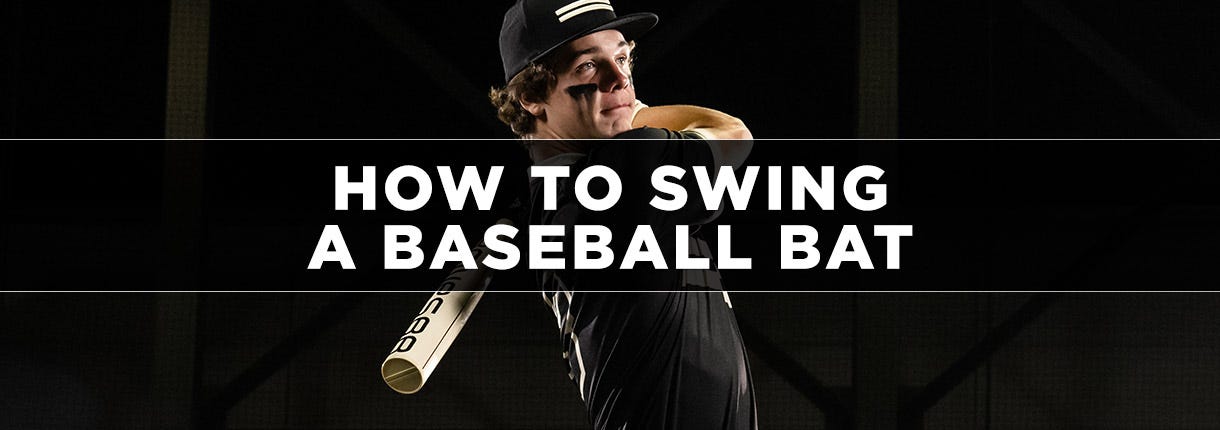How To Swing a Baseball Bat: Step-by-Step Guide

Swinging a baseball bat might seem straightforward, but achieving the perfect combination of power and precision requires more than brute strength. For both new and seasoned players, the key to becoming a consistent and successful hitter lies in refining the proper technique. This article aims to demystify the baseball swing, breaking it down into clear, actionable steps that will help you unlock the full potential of your swing. Whether you're looking to boost your power at the plate or simply hit the ball more consistently, understanding the mechanics of a proper swing is essential to taking your game to the next level.
Proper Baseball Swing Mechanics
The foundation of a great hitter is built on proper swing mechanics. While raw talent and athleticism play their roles, understanding and mastering these mechanics set elite hitters apart. Consistency, power, and accuracy are all byproducts of a well-executed swing, making it essential for players at all levels to focus on the core principles behind it. By honing the key elements—stance, grip, weight transfer, bat path, and follow-through—you'll not only make more frequent and powerful contact but also reduce the likelihood of injury. Let's break down each of these components:
- Stance
- The stance is the starting point for every swing. A balanced, athletic position enables you to react quickly to pitches while maintaining stability throughout the motion. Having the Proper Batting Stance for Baseball Players sets the stage for the rest of your swing, providing a strong foundation for generating power and controlling your bat speed.
- Grip
- Your grip on the bat can affect everything from bat control to power generation. A proper grip allows you to manage bat speed while maintaining control through the swing zone. Understanding how to grip the bat, and even How to Regrip a Bat when necessary, can make a significant difference in your performance at the plate.
Button: Shop Our Batting Accessories & Wrap.
- Your grip on the bat can affect everything from bat control to power generation. A proper grip allows you to manage bat speed while maintaining control through the swing zone. Understanding how to grip the bat, and even How to Regrip a Bat when necessary, can make a significant difference in your performance at the plate.
- Weight Transfer
- One of the most crucial aspects of the swing is weight transfer, which is how you shift your weight from your back foot to your front foot. Proper weight transfer helps generate power and ensures you're not off-balance during your swing. When done correctly, it allows you to maximize your energy and momentum, leading to harder, more controlled hits.
- Bat Path
- The bat path is the trajectory your bat follows through the hitting zone. A proper bat path is essential for making consistent contact and driving the ball with authority. A level or slightly upward bat path allows you to square up pitches and hit line drives.
- Follow-Through
- A good follow-through helps maintain the momentum of your swing and ensures that you’ve maximized your power output. It’s also a sign that you’ve stayed balanced throughout the swing. A fluid follow-through can help prevent unnecessary strain on your muscles, reducing injury risk and keeping your swing smooth and consistent.
By focusing on these foundational mechanics, hitters can gain a more in-depth understanding of how to consistently generate power and precision at the plate. Whether you’re a beginner or an experienced player, mastering these elements will make you a more dangerous and reliable hitter.
Step-by-Step Baseball Swing Guide
Pre-Swing Setup
- Stance: Stand with your feet shoulder-width apart, knees slightly bent, and weight evenly distributed. Your feet should be pointed at the plate with the bat resting between your shoulder and your ear.
- Grip: Hold the bat firmly but not too tight. Your knuckles should align, and the bat should rest in your fingers rather than your palms.
- Posture: Keep your back straight, bend slightly at the waist, and make sure your head is level. Stay relaxed and balanced.
- Eyeing the Pitcher: Focus on the pitcher’s release point, keeping your eyes locked on the ball from when it leaves the hand. Stay calm and ready to react.
- Load: Shift your weight slightly to your back leg, preparing to transfer it forward during the swing.
Initiating the Swing
- Load: As the pitcher winds up, shift your weight slightly onto your back leg to prepare for a powerful forward movement.
- Stride: Take a small, controlled step with your front foot toward the pitcher, ensuring your body stays balanced. Your stride should be smooth and not too long.
- Hands: As you stride, keep your hands back, ready to launch the bat forward. Your hands should stay relaxed but firm on the bat.
- Hips: Begin rotating your hips toward the ball, initiating the movement of your swing while keeping your upper body aligned.
- Bat Path: Start the bat’s forward motion, leading with the knob of the bat toward the ball while keeping the barrel in the proper path.
Contact and Follow-Through
- Contact Point: As the bat approaches the ball, ensure your eyes are locked on the contact point. Your front foot should be firmly planted, and your weight should be shifting from your back leg to your front leg.
- Square the Barrel: Aim to make contact with the ball using the sweet spot of the bat. Your hands should stay inside the ball, with the barrel angled slightly upward.
- Hand Position: Keep your top hand strong and palm up at contact, while your bottom hand stays palm down. This helps generate power and keeps the bat in the correct hitting plane.
- Hip Rotation: At the moment of contact, your hips should be fully rotated toward the pitcher, providing the torque necessary for power. Avoid stopping your hip rotation too early.
- Extend Through the Ball: After contact, extend your arms fully in the direction of the pitch, ensuring your bat stays on the same path. This extension maximizes the follow-through and helps direct the ball’s flight.
- Follow-Through: Allow the bat to naturally continue its path after contact. Your upper body should remain balanced, and your back foot can pivot to allow for a full rotation. A smooth, high follow-through will help maintain control and power.
Common Mistakes in Baseball Batting Swing
- Overstriding: Taking too large of a step during the swing can throw off balance and timing.
- Correction: Keep the stride short and controlled, focusing on balance rather than distance.
- Dropping Hands: Lowering your hands before the swing leads to weak contact or pop-ups.
- Correction: Keep your hands at shoulder height and avoid dipping them before swinging.
- Opening Front Shoulder Too Early: Turning your front shoulder too soon, causes a loss of power and poor bat control.
- Correction: Keep your front shoulder closed until your hips start to rotate, allowing for more powerful, controlled swings.
- Casting the Bat: Extending your arms too early, results in slower bat speed and weak contact.
- Correction: Keep your hands close to your body and "inside" the ball until the bat's forward movement begins.
- Poor Weight Transfer: Failing to shift weight from the back foot to the front, reducing power.
- Correction: Practice a smooth weight transfer, starting from the back leg and moving forward with the stride.
- Inconsistent Bat Path: Swinging on different planes or not keeping the bat on the plane leads to inconsistent contact.
- Correction: Focus on maintaining a level bat path and keeping the barrel in the hitting zone longer.
Expert Tips on Swinging a Bat
Drills for Refining Batting Technique
- Tee Work: Focus on proper mechanics by hitting balls off a tee. Tee work allows hitters to work on their stance, bat path, and contact without worrying about pitch timing.
- Goal: Improve consistency and refine mechanics.
- Soft Toss: A partner underhand tosses the ball from the side while you focus on making solid contact.
- Goal: Develop timing and hand-eye coordination while maintaining proper swing mechanics.
- One-Handed Swings: Practice swings using only your top or bottom-hand.
- Goal: Strengthen hand control and improve the efficiency of the bat path.
- Hip Rotation Drill: Stand with your feet planted and use a half-swing to focus on rotating your hips.
- Goal: Enhance lower body mechanics and generate more power from hip rotation.
- Heavy Bat Swings: Practice with a heavier bat to build strength and increase bat speed.
- Goal: Improve bat speed and control during your regular swings.
- Front Toss Drill: A coach or partner tosses balls from a close distance in front of you while you work on tracking and timing.
- Goal: Enhance timing, rhythm, and focus on proper contact.
- Short Bat Drill: Use a short bat to work on keeping the hands inside the ball and maintaining a proper bat path.
- Goal: Improve bat control and prevent casting during the swing.
- Pitch Recognition Drill: Have a coach mix in different types of pitches (fastballs, changeups, curveballs) while you practice identifying the pitch type and adjusting your swing.
- Goal: Improve pitch recognition and decision-making at the plate.
- Overhand Batting Practice: Help hitters improve their timing, hand-eye coordination, and reaction to live pitching.
- Goal: Help Hitters develop a smooth controlled swing. This is also a great opportunity it break in a new bat. For a step-by-step guide on how to break in your bat, check out our article How to Break in a Baseball or Softball Bat: Step-by-Step Guide
Insights from Professional Players
- “Don’t forget to swing hard, in case you hit the ball.” - Woodie Held
- “I swing big, with everything I’ve got. I hit big or I miss big. I like to live as big as I can” - Babe Ruth
- “The pitcher has got only a ball. I’ve got a bat. So the percentage in weapons is in my favor and I let the fellow with the ball do the fretting” - Hank Aaron
- “Don’t let the fear of striking out hold you back” - Babe Ruth
- “Hitting is fifty percent above the shoulders” - Ted Williams
Focus, Timing, and Pitch Recognition
The psychological components of hitting are just as crucial as physical mechanics, as they directly impact focus, timing, and pitch anticipation. Mental preparation helps hitters stay calm under pressure and block out distractions, which is essential for maintaining focus. One effective strategy is using visualization techniques to picture success at the plate before stepping into the batter's box. Timing can be improved by mastering pitch recognition and tracking the ball from the pitcher’s hand, which helps anticipate the speed and type of pitch. Additionally, learning to stay relaxed and confident, even after failures, builds mental resilience, allowing hitters to make quicker adjustments and better decisions in real time.
How To Swing a Baseball Bat FAQs
How often should I practice my baseball swing?
For beginners, practicing 3-4 times a week builds solid mechanics and muscle memory without overworking your body. Advanced players may practice daily, but consistent, quality reps and rest days are crucial to avoid fatigue and injury.
What equipment can help me improve my batting technique?
Equipment like a batting tee, weighted training bats, and hitting nets can help you focus on mechanics and build strength. Pitching machines and batting gloves further enhance your practice by allowing for controlled reps and grip stability.
How can I increase my bat speed?
To increase bat speed, focus on strengthening your core and legs through exercises like squats and rotational work, while refining your swing mechanics. Using weighted bats and resistance bands in practice also helps condition your muscles for faster swings.
What are the benefits of video analysis in refining my swing?
Video analysis helps you spot mechanical flaws and track your progress over time, allowing for targeted improvements. By reviewing each aspect of your swing frame by frame, you can make precise adjustments to improve consistency and power.
Does strength training improve my baseball swing?
Yes, strength training improves swing power by building leg stability, core rotation, and upper body strength. Exercises that target these areas help you generate more force and control during your swing, leading to better performance at the plate.








